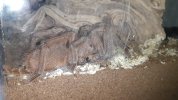Hagraven
Well-Known Member
- Messages
- 137
- Location
- United States
Hi all,
I recently brought home an Asia Fawn tarantula, who I named Lolth. I do not know the sex of the tarantula but they are about 5 to 6 inches in size. The petstore that sold me the tarantula claimed to have them only a week or so before I came along. Unfortunately they for whatever reason had not given Lolth a water dish and when I got them home I noticed that their abdomen was slightly shriveled (when I had their water dish full the poor thing practically ran to it). Now, only days later the abdomen is starting to look fuller and healthier looking.
Since I brought them home I've seen a stressed, legs up posture (see picture). And day by day I notice more and more webbing going up.
I had assumed that having been relocated from wherever they had been before arriving at the petstore, and then again to my home in such a short time period (2 moves in 2-3weeks) might be the reason for their seemingly stressed and generally unhappy posture. Also- I had earlier replaced a hide in their enclosure (not smart I know), and they were very quick to let me know how irritated that made them.
However, they are now refusing food (but earlier ate two large crickets) and with webbing sort of barricading themselves in their chosen corner. Just today however I watched them leave this spot to drink, and when they returned, they put down webs as if to "close the door behind them." Also, they seem kinda "shabby," as I heard it said about some premolting tarantulas (you can see in one of the photos that there are some dark spots all over their cephalothorax).
I have to consider that this could be pre-molting behavior?
After all this I have left them alone and am trying my best to be as quiet and gentle around the enclosure as possible. Again, new webbing every morning (so pretty!), stressed, legs- posture (see picture), refusing food.
So, my questions to you kind people:
1. I am thinking of removing the crickets Lolth has no interest in, wanting to avoid any accidents if they are indeed going to molt- but I am worried my attempts to remove said crickets will cause Lolth additional, unnecessary stress? Think I should wait a few more days and see what goes on?
2. Given the stress of moving so much/not eating/but also knowing that the species webs extensively, what are your thoughts on their posture and the webs, sealing them up? Molting behavior, as well as stress? Something else?
I want only for this amazing critter to be healthy and happy. I really appreciate your advice. Thanks friends
I recently brought home an Asia Fawn tarantula, who I named Lolth. I do not know the sex of the tarantula but they are about 5 to 6 inches in size. The petstore that sold me the tarantula claimed to have them only a week or so before I came along. Unfortunately they for whatever reason had not given Lolth a water dish and when I got them home I noticed that their abdomen was slightly shriveled (when I had their water dish full the poor thing practically ran to it). Now, only days later the abdomen is starting to look fuller and healthier looking.
Since I brought them home I've seen a stressed, legs up posture (see picture). And day by day I notice more and more webbing going up.
I had assumed that having been relocated from wherever they had been before arriving at the petstore, and then again to my home in such a short time period (2 moves in 2-3weeks) might be the reason for their seemingly stressed and generally unhappy posture. Also- I had earlier replaced a hide in their enclosure (not smart I know), and they were very quick to let me know how irritated that made them.
However, they are now refusing food (but earlier ate two large crickets) and with webbing sort of barricading themselves in their chosen corner. Just today however I watched them leave this spot to drink, and when they returned, they put down webs as if to "close the door behind them." Also, they seem kinda "shabby," as I heard it said about some premolting tarantulas (you can see in one of the photos that there are some dark spots all over their cephalothorax).
I have to consider that this could be pre-molting behavior?
After all this I have left them alone and am trying my best to be as quiet and gentle around the enclosure as possible. Again, new webbing every morning (so pretty!), stressed, legs- posture (see picture), refusing food.
So, my questions to you kind people:
1. I am thinking of removing the crickets Lolth has no interest in, wanting to avoid any accidents if they are indeed going to molt- but I am worried my attempts to remove said crickets will cause Lolth additional, unnecessary stress? Think I should wait a few more days and see what goes on?
2. Given the stress of moving so much/not eating/but also knowing that the species webs extensively, what are your thoughts on their posture and the webs, sealing them up? Molting behavior, as well as stress? Something else?
I want only for this amazing critter to be healthy and happy. I really appreciate your advice. Thanks friends


